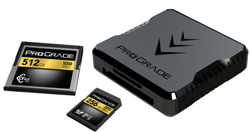A group of former Lexar executives headed by ex-Lexar VP Wes Brewer have emerged with a new ‘son of Lexar’ premium memory card brand, ProGrade Digital. There are no plans at present to launch in Australia.
 The Lexar name and existing product was purchased in 2017 by Chinese company, Longsys.
The Lexar name and existing product was purchased in 2017 by Chinese company, Longsys.
‘Our goal is to be the professional’s source for top performing, professional grade memory cards and workflow solutions,’ says Wes Brewer, ProGrade Digital’s founder and CEO. ‘We will be committed to focusing our efforts on the digital imaging pro who is meticulous about his equipment and workflow—delivering the best service, plus best product quality and reliability.’
ProGrade Digital – combining a self-describing brand and Lexar-like livery, will focus on the highest quality, professional grade memory cards and workflow solutions for high-end DLSRs, camcorders and digital cinema cameras. Memory cards will be offered in a variety of formats and capacities. The company will also design and market a selection of card readers, starting with a CFast & SD Dual Slot Workflow Reader with a USB 3.1, Gen. 2 transfer protocol.
The company already offers a 512GB CFast card that’s the fastest on the market, according to a report in US website, Imaging Resource. While the failure rate for Lexar pro cards was 2 percent overall, ProGrade is aiming for a 0 percent failure rate.
ProGrade Digital’s new memory cards and card readers will initially be available online via its own website along with Amazon.com and B&H Photo and Video. The global roll-out the US and Canada, then Europe, China, Japan and the rest of the world. But as Australia was well-supported in Australia (and vice versa) one might anticipate ProGrade Digital products in this market sooner rather than later.
Wes Brewer gave Imaging Resource an insight into why Micron decided to close down the Lexar business, in an environment where supply of NAND memory was constrained: ‘That shortage of supply meant that manufacturers had to decide where they were going to put their capital, and what markets they were going to serve. At Micron, that was data centers and enterprise storage. So then they asked themselves if they really wanted to be producing a $4.99 drive to be sold at Target and not make any money with the heavy complexity of retail costs and things like that.’
– ProGrade’s focus on the higher-margin premium sector should help it avoid that trap.





Be First to Comment